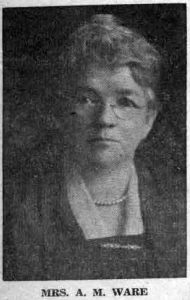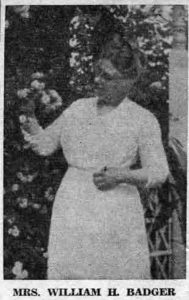On Wednesday, October 21, the Annual Ingathering of the Wayne Branch of the Needlework Guild will be held in the Parish House of St. Mary’s Church on Lancaster Pike and Louella avenue. This pleasant occasion will mark the 63rd annual meeting of Wayne’s needlework Guild, one of the oldest groups of that great national organization aptly described as the “charity that helps other charities”.
 The first small beginnings of the Needlework Guild were not in this country. They go back to a day in Wales in the early 1880’s when a mine disaster left scores of children homeless. A generous hearted English woman, Lady Wolverton, solicited the aid of her friends in founding an orphanage at Iwerne, Dorchestershire, England, where these children could be fed and sheltered.
The first small beginnings of the Needlework Guild were not in this country. They go back to a day in Wales in the early 1880’s when a mine disaster left scores of children homeless. A generous hearted English woman, Lady Wolverton, solicited the aid of her friends in founding an orphanage at Iwerne, Dorchestershire, England, where these children could be fed and sheltered.
With the completion of this building in 1882 there came the problems of clothing, bedding and other articles essential to even the meager existence they would have there. Once again Lady Wolverton turned to her friends for aid with this plea, “Help to make and care for the children’s wardrobe by giving two new garments”. It is said that these friends knitted and sewed until the children were completely outfitted.
Lady Wolverton’s little group of sewers and knitters, whom she had named “The Needlework Guild”, attracted attention not only among the townspeople, but throughout all England as well. Finally, under royal auspices, the London Needlework Guild was formed. And then an American woman, Mrs. Alanson Hartpeuce, as she traveled through England, became so impressed by the work of this group that she brought back to America word of its activities. In consequence her niece, Miss Laura Safford (later Mrs. John Wood Stewart) with the help of her friends formed “The Needlework Guild of Philadelphia”, the forerunner of the present national organization.
This Philadelphia group aimed to have each one of its members contribute annually two or more new articles of wearing apparel or household linen. The principle of contributing “new” articles was important since the pride of possession of a new garment served to boost the morale of the needy recipients.
By 1891 the charitable work of the Needlework Guild of Philadelphia had spread to such an extent that its leaders decided to change its name to the more comprehensive one of “The Needlework Guild of America”. Five years later this non-sectarian organization was formally incorporated “for the purpose of collecting new garments and distributing them to hospitals, homes and other charities and of forming and governing branches of the said Guild organized for similar work”. By the turn of the century many new branches were being formed in towns and cities throughout the United States. To meet the financial problems of this expansion, membership was now granted to those who wished to contribute towards the extension and maintenance of the work. Thus many men became supporters of the Needlework Guild.
By 1907 the Guild had become affiliated with the American Red Cross in order to cooperate with the latter “in times of international, national and local disaster”. In 1909 it also became affiliated with the General Federation of Women’s Clubs and in 1906 had become a member of the National Conference of Social Work.
Its activities were far from routine, as witnessed by the part it played in relief work during the Johnstown and Dayton floods, the San Francisco earthquake and fire and many other lesser known local disasters. At the outbreak of World War I workrooms were set up in Lyons, France, to help those left homeless, while in New York the War Relief Department was established, continuing to render assistance to the Allied countries as late as 1931. During World War II the most important work of the Needlework Guild was to provide clothing for the families of American servicemen. This was a gigantic project which required the combined efforts of all the branches of the Needlework Guild.
 Wayne’s part in the work of this organization dates back more than 62 years, for it was at a meeting in the room of the Wayne Library on March 19, 1891, that the local branch was formed. On this occasion Mrs. Thomas H. Morrison, president of the Parent Guild, was present and explained the object of the work, after which the meeting was organized.
Wayne’s part in the work of this organization dates back more than 62 years, for it was at a meeting in the room of the Wayne Library on March 19, 1891, that the local branch was formed. On this occasion Mrs. Thomas H. Morrison, president of the Parent Guild, was present and explained the object of the work, after which the meeting was organized.
The first president was Mrs. Arthur W. Howell, who served in that capacity for several years. The first vice-presidents were four in number, namely Mrs. Edward Pugh, Mrs. Henry Pleasants, Mrs Joseph W. Paul and Miss Anna C. Matlack. Miss Agnes Ellis Boyd became the first secretary of the Wayne organization.
The list of the first directors is made up of names of women well known for their interest in community and church work in Wayne in the 1890’s. They were Mrs. Samuel A. Abbott, Mrs. A.M. Ware, Mrs. John Miller, Mrs. I.K. Conrad, Mrs. R.C. Peterson, Mrs. F.W. Farrell, Mrs. George M. Wells, Mrs. George W. Chapin, Mrs. George R. Stoeker, Mrs. A.J. Wiltburger, Mrs. W.A. Wiltburger, Mrs. H.D. Hughes, Mrs. Alfred Wetherall, Mrs. J.L. Wentworth, Mrs. Louis Johnson, Mrs. Joseph Shock, Mrs. J.P.P. Brown, Mrs. R.B. Okie, Mrs. W. Livingston Boyd, Mrs. John Adler, Mrs. Henry Pleasants, Mrs. William Goodrich, Mrs. William Stroud, Mrs. Frank Smith and Miss C. Pleasants. Then, as now, each of these directors was responsible for the collection of new garments for the annual meeting to be held in October of that year.
By the time this meeting took place the names of two other well known Wayne women had been added to the list of directors, Mrs. W.H. Badger and Mrs. Richard Johnson.
More than 800 garments had been collected by these directors. Among the institutions to which they were sent were the Bethany Home, the Maternity Home, the Children’s Aid Society, the Western Temporary Home and the Consumption Home for Women, all Philadelphia institutions. One closer to home was the Hospital of the Good Shepherd in Rosemont. In addition there were several recipients in other parts of the state.
Shown in this week’s column are the pictures of Mrs. A.M. Ware, one of the founders of the Wayne Needlework Guild and Mrs. W.H. Badger, who joined the guild shortly afterwards.
(To be concluded)
